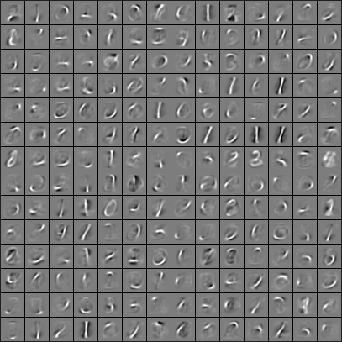Exercise:Self-Taught Learning
Contents[hide] |
Overview
In this exercise, we will use the self-taught learning paradigm with the sparse autoencoder and softmax classifier to build a classifier for handwritten digits.
You will be building upon your code from the earlier exercises. First, you will train your sparse autoencoder on an "unlabeled" training dataset of handwritten digits. This produces feature that are penstroke-like. We then extract these learned features from a labeled dataset of handwritten digits. These features will then be used as inputs to the softmax classifier that you wrote in the previous exercise.
Concretely, for each example in the the labeled training dataset  , we forward propagate the example to obtain the activation of the hidden units
, we forward propagate the example to obtain the activation of the hidden units  . We now represent this example using
. We now represent this example using (the "replacement" representation), and use this to as the new feature representation with which to train the softmax classifier.
(the "replacement" representation), and use this to as the new feature representation with which to train the softmax classifier.
Finally, we also extract the same features from the test data to obtain predictions.
In this exercise, our goal is to distinguish between the digits from 0 to 4. We will use the digits 5 to 9 as our "unlabeled" dataset which which to learn the features; we will then use a labeled dataset with the digits 0 to 4 withwhich to train the softmax classifier.
In the starter code, we have provided a file stlExercise.m that will help walk you through the steps in this exercise.
Dependencies
The following additional files are required for this exercise:
You will also need your code from the following exercises:
If you have not completed the exercises listed above, we strongly suggest you complete them first.
Step 1: Generate the input and test data sets
Download and decompress stl_exercise.zip, which contains starter code for this exercise. Additionally, you will need to download the datasets from the MNIST Handwritten Digit Database for this project.
Step 2: Train the sparse autoencoder
Next, use the unlabeled data (the digits from 5 to 9) to train a sparse autoencoder, using the samesparseAutoencoderCost.m function as you had written in the previous exercise. (From the earlier exercise, you should have a working and vectorized implementation of the sparse autoencoder.) For us, the training step took less than 25 minutes on a fast desktop. When training is complete, you should get a visualization of pen strokes like the image shown below:
Informally, the features learned by the sparse autoencoder should correspond to penstrokes.
Step 3: Extracting features
After the sparse autoencoder is trained, you will use it to extract features from the handwritten digit images.
Complete feedForwardAutoencoder.m to produce a matrix whose columns correspond to activations of the hidden layer for each example, i.e., the vectora(2) corresponding to activation of layer 2. (Recall that we treat the inputs as layer 1).
After completing this step, calling feedForwardAutoencoder.m should convert the raw image data to hidden unit activationsa(2).
Step 4: Training and testing the logistic regression model
Use your code from the softmax exercise (softmaxTrain.m) to train a softmax classifier using the training set features (trainFeatures) and labels (trainLabels).
Step 5: Classifying on the test set
Finally, complete the code to make predictions on the test set (testFeatures) and see how your learned features perform! If you've done all the steps correctly, you should get an accuracy of about98% percent.
As a comparison, when raw pixels are used (instead of the learned features), we obtained a test accuracy of only around 96% (for the same train and test sets).
from: http://ufldl.stanford.edu/wiki/index.php/Exercise:Self-Taught_Learning






















 570
570











 被折叠的 条评论
为什么被折叠?
被折叠的 条评论
为什么被折叠?








